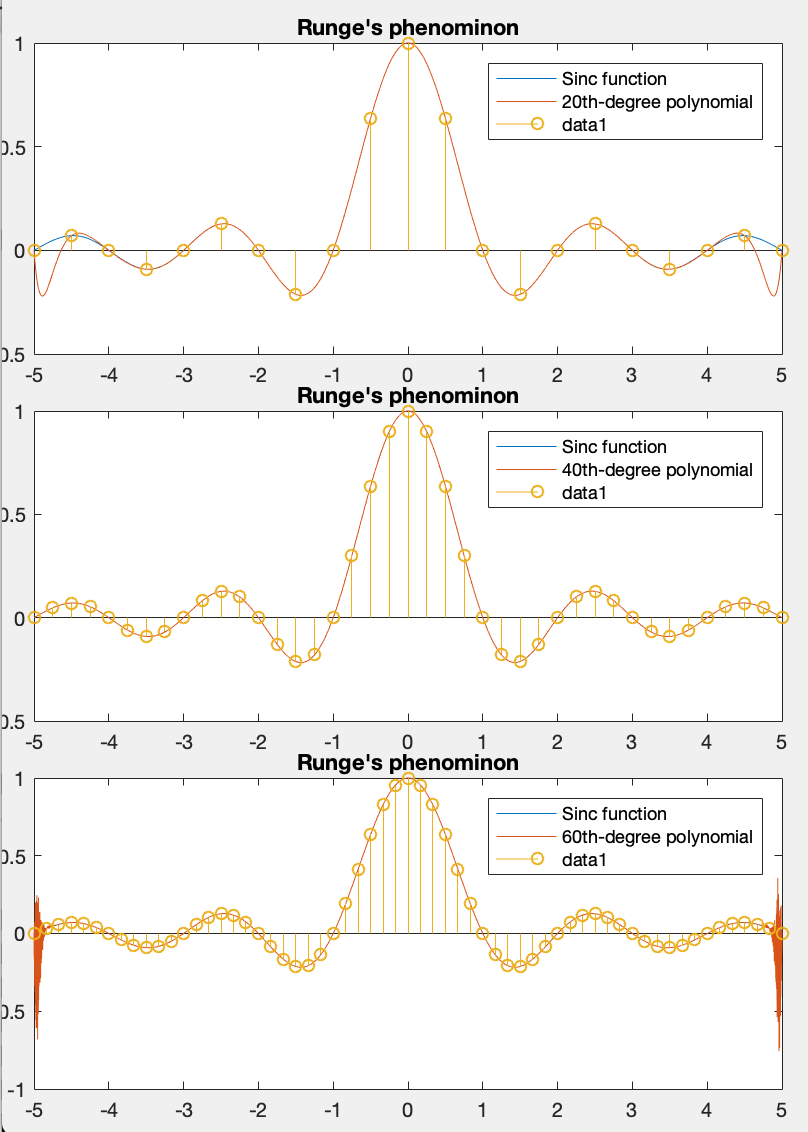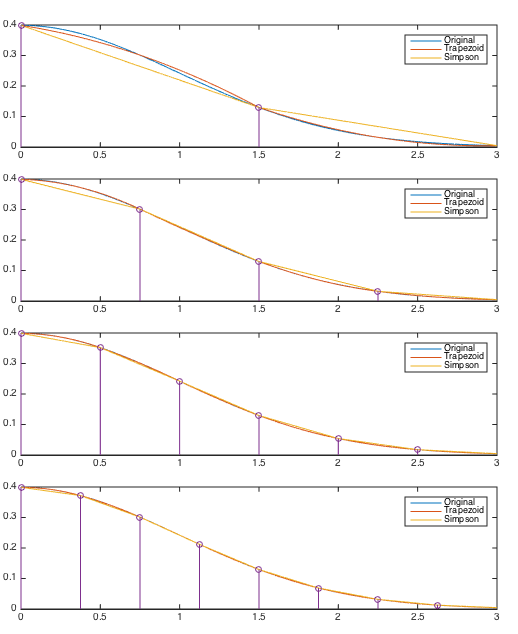Next: Undetermined Coefficients Up: Numerical Integration and Differentiation Previous: Newton-Cotes Quadrature
The Newton-Cotes quadrature rules estimate the integral
of a function 
![$[a,\;b]$](img231.svg)





The figure below shows the approximation of the sinc
function





To avoid this problem, the composite quadrature rules
can be used, which subdivides the entire integral interval
![$[a,\;b]$](img231.svg)



![$I[f]$](img76.svg)


![$\displaystyle I[f]=\int_a^b f(x)dx=\sum_{j=0}^{N-1} \int_{x_j}^{x_{j+1}} f(x) dx
\approx\sum_{j=0}^{N-1} \left(\sum_{i=0}^n c_{ij} f_{ij}\right)$](img240.svg) |
(70) |
 is the ith function value in the jth subinterval
weighted by the coefficient
is the ith function value in the jth subinterval
weighted by the coefficient  , which can be found as in
Eq. (29) with
, which can be found as in
Eq. (29) with  replaced by
replaced by
 .
.
 ):
):
![$\displaystyle E_n[f]=-\sum_{j=0}^{N-1}\frac{h^3}{12}f''(\eta_j)
=-\frac{h^3}{12}\sum_{j=0}^{N-1}f''(\eta_j),
\;\;\;\;\;\;\eta_j\in(x_j,\,x_{j+1})$](img247.svg) |
(72) |
 |
(73) |
 at which
at which
 |
(74) |
![$\displaystyle E[f]=-\frac{h^3}{12}Nf''(\eta)=-\frac{(b-a)^3}{12\,N^2}f''(\eta)$](img251.svg) |
(75) |
![$E[f]$](img252.svg) is quickly reduced when
is quickly reduced when  is increased.
is increased.
 ):
):
![$\displaystyle I[f]$](img244.svg) |
 |
![$\displaystyle \int_a^b f(x)\,dx=\sum_{j=0}^{N-1}\int_{x_j}^{x_{j+1}}f(x)\,dx
\a...
...1}{2}\;\sum_{j=0}^{N-1}\frac{h}{3}
\left[f(x_j)+4f(x_{j+1/2})+f(x_{j+1})\right]$](img253.svg) |
|
 |
![$\displaystyle \frac{h}{6}\left[f(a)+4\sum_{j=0}^{N-1}f(x_{j+1/2})
+2\sum_{j=1}^{N-1}f(x_j)+f(b)\right]$](img254.svg) |
||
 |
![$\displaystyle \frac{h}{6}\left[f(a)+4\sum_{j=0}^{N-1}f(a+(j+1/2)h)
+2\sum_{j=1}^{N-1}f(a+jh)+f(b)\right]$](img255.svg) |
![$\displaystyle E_s[f]=-\frac{(h/2)^5}{90}\;N\,\sum_{j=0}^{N-1}f^{(4)}(\eta_j)
=-...
...-a)^5}{90\,N^4} f^{(4)}(\eta)
=-\frac{(b-a)^5}{2880}\frac{1}{n^4} f^{(4)}(\eta)$](img256.svg) |
(76) |
 ):
):
![$\displaystyle I[f]$](img244.svg) |
 |
![$\displaystyle \int_a^b f(x)\,dx\approx
\frac{1}{3}\sum_{j=0}^{N-1}\frac{3h}{8}\left[f(x_j)+3f(x_{j+1/3})
+3f(x_{j+2/3})+f(x_{j+1})\right]$](img257.svg) |
|
 |
![$\displaystyle \frac{h}{8}\left[f(a)+3\sum_{j=0}^{N-1}f(x_j+h/3)
+3\sum_{j=0}^{N-1}f(x_j+2h/3)+2\sum_{j=1}^{N-1}f(x_j)+f(b)\right]$](img258.svg) |
 ):
):
![$\displaystyle I[f]$](img244.svg) |
 |
![$\displaystyle \int_a^b f(x)\,dx\approx
\frac{1}{4}\sum_{j=0}^{N-1}\frac{2h}{45}\left[7f(x_j)+32f(x_{j+1/4})
+12f(x_{j+2/4})+32f(x_{j+3/4})+7f(x_{j+1})\right]$](img259.svg) |
|
 |
![$\displaystyle \frac{h}{90}\left[f(a)+32\sum_{j=0}^{N-1}f(x_j+h/4)
+12\sum_{j=0}...
...f(x_j+2h/4)+32\sum_{j=0}^{N-1}f(x_j+3h/4)
+14\sum_{j=1}^{N-1}f(x_j)+f(b)\right]$](img260.svg) |
The Matlab function below estimates the integral of a given
function 
![$[a,\;b]$](img231.svg)

function CompositeQuadrature(f,a,b,n,N)
h=(b-a)/N; % length of each of the N subintervals
for n=1:4 % for each of the n polynomials
I=0;
c=coefs(n); % quadrature coefficients of the nth polynomial
for i=0:N-1 % for each of N intervals
j=a+i*h; % starting point for the ith interval
for m=0:n % add each of the n terms
I(n)=I(n)+c(m+1)*f(j+m*h/n);
end
end
I=h*I/n;
fprintf('n=%d\tI=%f\n',n,I);
end
end
Example: Reconsider the integral in the previous example:
 |
(77) |
 and
and  are divided
into
are divided
into  sub-intervals with
sub-intervals with
 and
and  . The results are
listed in the table below. We see that in general the quadratic
approximation by Simpson's method is of course more accurate than
the linear approximation by the trapezoidal method. Also, when
the interval
. The results are
listed in the table below. We see that in general the quadratic
approximation by Simpson's method is of course more accurate than
the linear approximation by the trapezoidal method. Also, when
the interval  is divided into more subintervals each
approximated by either of the two methods, higher accuracy can
be achieved.
is divided into more subintervals each
approximated by either of the two methods, higher accuracy can
be achieved.

 |
Taylor expansion of 



 |
(78) |